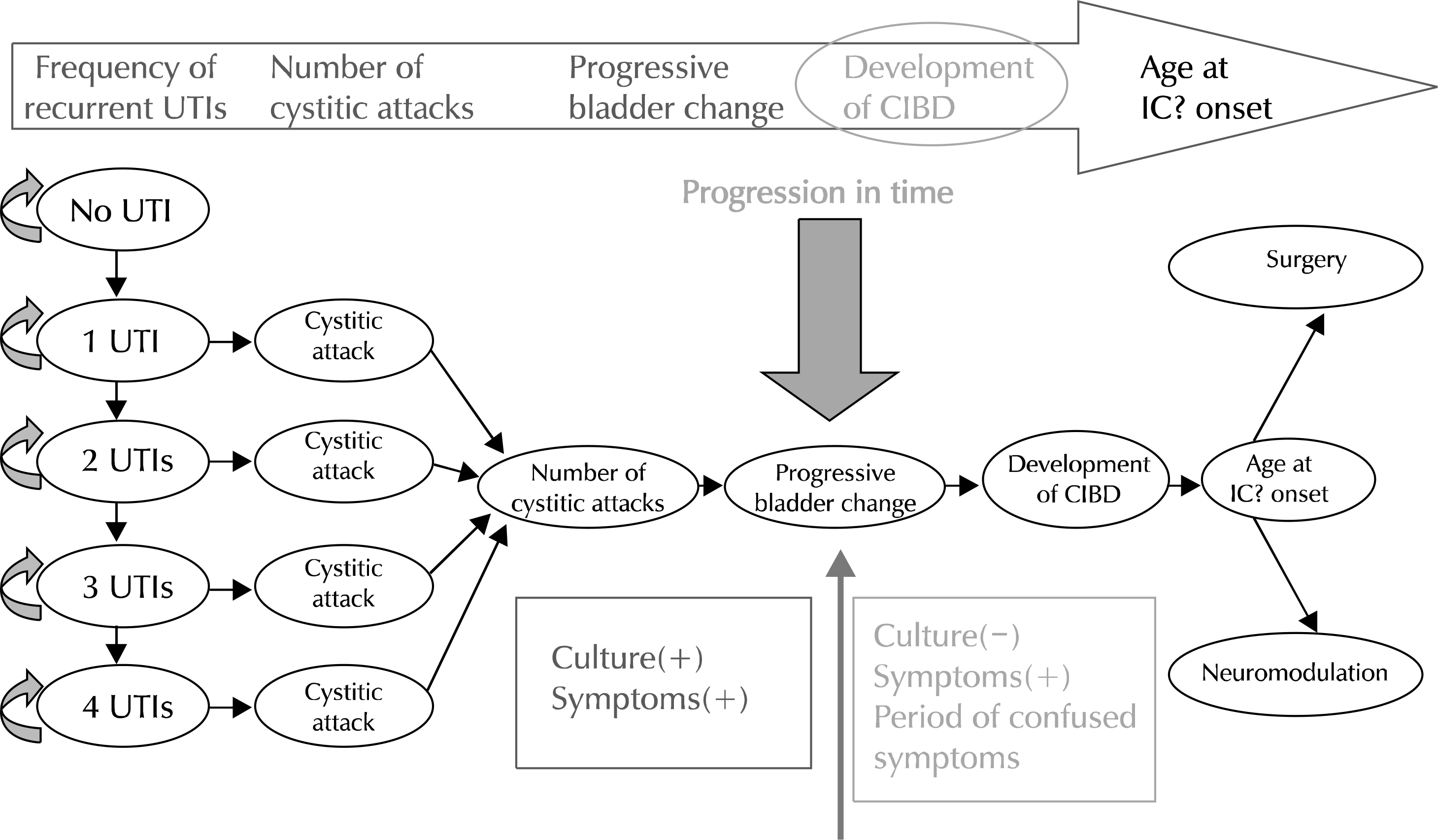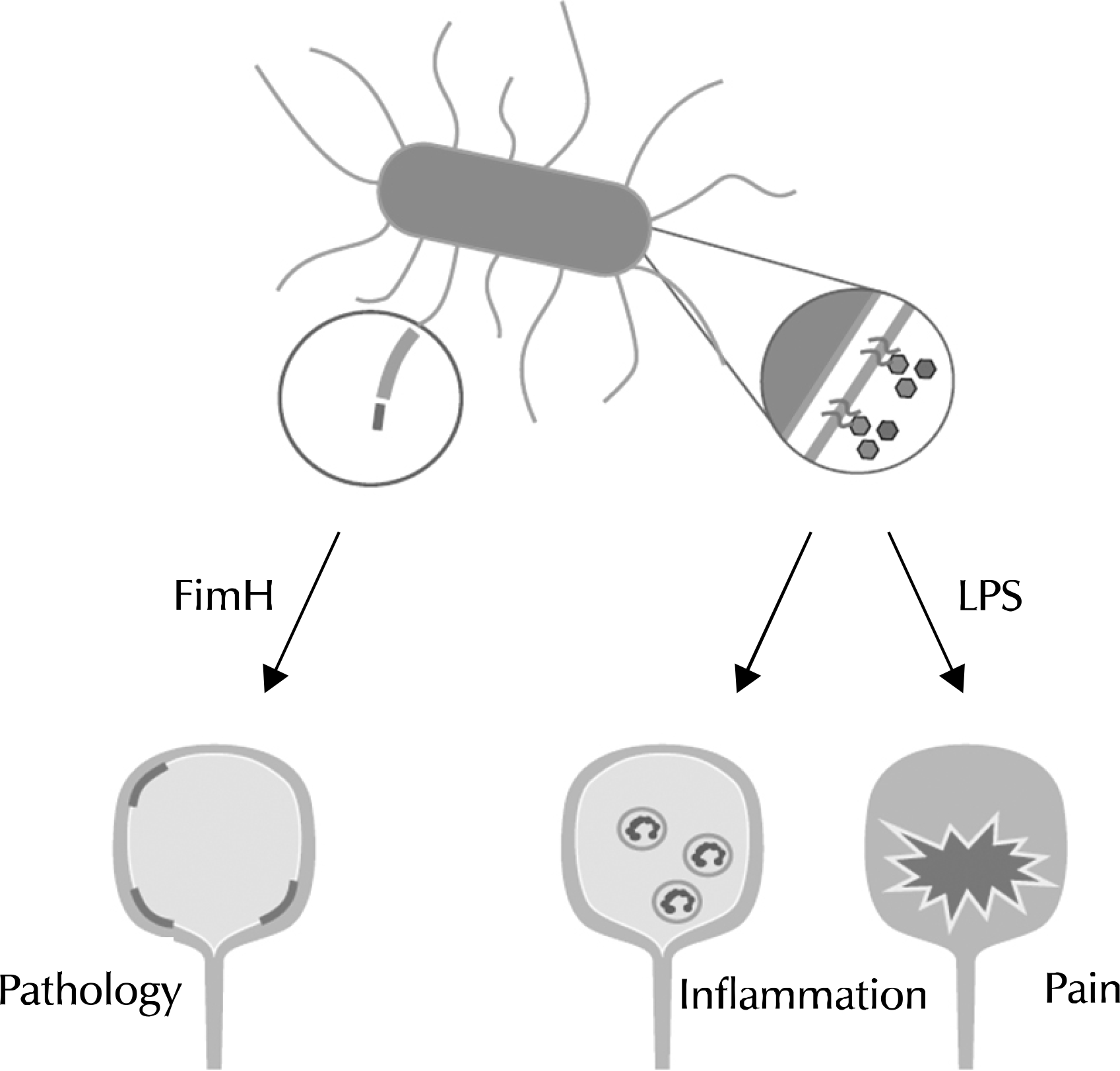Abstract
Urinary tract infection (UTI) in most cases is accompanied by pain. However, in some cases, including asymptomatic bacteriuria (ASB), pain is absent and thus, cannot be characterized. A study with an animal UTI model to quantify pelvic pain showed that Escherichia coli (NU14 strains) isolated from urine of patients with acute UTI caused pain, while E. coli (83972 strains) isolated from urine of patients with ASB caused no pain. The difference in pain response was not related to bladder colonization or inflammation, but to lipopolysaccharde (LPS) and Toll-like receptor 4, which is an LPS receptor. As the association between interstitial cystitis (IC) and UTI was epidemiologically suggested, an experiment was performed to investigate whether repeated infection with uropathogenic E. coli (UPEC) causes chronic pain through central sensitization. The results showed that repeated infection with the wild type UPEC caused temporary pain, while repeated infection with UPEC (SΦ 874 strains) in the absence of O-antigen caused chronic pain. Chronic pain following UTI is related to voiding dysfunction and anxious/depressive behavior. These relationships are mediated by transient receptor potential vanilloid type 1 at the stage of pain development and by C-C chemokine receptor type 2 at the stage of pain maintenance. Based on these findings, temporary E. coli infection causes chronic pain, which is one of the characteristics of neuropathic pain. This pattern is similar with the symptoms of IC, supporting the possibility of infection as an etiology of IC.
REFERENCES
1.Roos V., Ulett GC., Schembri MA., Klemm P. The asymptomatic bacteriuria Escherichia coli strain 83972 outcompetes uropathogenic E. coli strains in human urine. Infect Immun. 2006. 74:615–24.
2.Mulvey MA., Schilling JD., Martinez JJ., Hultgren SJ. Bad bugs and beleaguered bladders: interplay between uropathogenic Escherichia coli and innate host defenses. Proc Natl Acad Sci U S A. 2000. 97:8829–35.

3.Nicolle LE., Bradley S., Colgan R., Rice JC., Schaeffer A., Hooton TM. Infectious Diseases Society of America guidelines for the diagnosis and treatment of asymptomatic bacteriuria in adults. Clin Infect Dis. 2005. 40:643–54.

4.Kim Y., Kim M. Inflammation and interstitial cystitis. Book of 2nd International Consultation on Interstitial Cystitis, Japan;2007. p. 33–7.
5.Bjorling DE., Wang ZY., Boldon K., Bushman W. Bacterial cystitis is accompanied by increased peripheral thermal sensitivity in mice. J Urol. 2008. 179:759–63.

6.Desireddi NV., Campbell PL., Stern JA., Sobkoviak R., Chuai S., Shahrara S, et al. Monocyte chemoattractant protein-1 and macrophage inflammatory protein-1alpha as possible biomar-kers for the chronic pelvic pain syndrome. J Urol. 2008. 179:1857–61. discussion 1861-2.
7.Rudick CN., Berry RE., Johnson JR., Johnston B., Klumpp DJ., Schaeffer AJ, et al. Uropathogenic Escherichia coli induces chronic pelvic pain. Infect Immun. 2011. 79:628–35.
8.Hedlund M., Duan RD., Nilsson A., Svanborg C. Sphingomyelin, glycosphingolipids and ceramide signalling in cells exposed to P-fimbriated Escherichia coli. Mol Microbiol. 1998. 29:1297–306.
9.Hedlund M., Svensson M., Nilsson A., Duan RD., Svanborg C. Role of the ceramide-signaling pathway in cytokine responses to P-fimbriated Escherichia coli. J Exp Med. 1996. 183:1037–44.

10.Mulvey MA., Schilling JD., Hultgren SJ. Establishment of a persistent Escherichia coli reservoir during the acute phase of a bladder infection. Infect Immun. 2001. 69:4572–9.
11.Schilling JD., Mulvey MA., Vincent CD., Lorenz RG., Hultgren SJ. Bacterial invasion augments epithelial cytokine responses to Escherichia coli through a lipopolysaccharide-dependent mechanism. J Immunol. 2001. 166:1148–55.
12.Svanborg C., Godaly G., Hedlund M. Cytokine responses during mucosal infections: role in disease pathogenesis and host defence. Curr Opin Microbiol. 1999. 2:99–105.

13.Mulvey MA., Lopez-Boado YS., Wilson CL., Roth R., Parks WC., Heuser J, et al. Induction and evasion of host defenses by type 1-piliated uropathogenic Escherichia coli. Science. 1998. 282:1494–7.

14.Justice SS., Hung C., Theriot JA., Fletcher DA., Anderson GG., Footer MJ, et al. Differentiation and developmental pathways of uropathogenic Escherichia coli in urinary tract pathogenesis. Proc Natl Acad Sci U S A. 2004. 101:1333–8.

15.Mysorekar IU., Hultgren SJ. Mechanisms of uropathogenic Escherichia coli persistence and eradication from the urinary tract. Proc Natl Acad Sci U S A. 2006. 103:14170–5.

16.Malterud K., Baerheim A. Peeing barbed wire. Symptom experiences in women with lower urinary tract infection. Scand J Prim Health Care. 1999. 17:49–53.
17.Rudick CN., Billips BK., Pavlov VI., Yaggie RE., Schaeffer AJ., Klumpp DJ. Host-pathogen interactions mediating pain of urinary tract infection. J Infect Dis. 2010. 201:1240–9.

18.Rudick CN., Jiang M., Yaggie RE., Pavlov VI., Done J., Heckman CJ, et al. O-antigen modulates infection-induced pain states. PLoS One. 2012. 7:e41273.

19.van Oosten M., van de Bilt E., de Vries HE., van Berkel TJ., Kuiper J. Vascular adhesion molecule-1 and intercellular adhesion molecule-1 expression on rat liver cells after lipopolysaccharide administration in vivo. Hepatology. 1995. 22:1538–46.
20.Backhed F., Soderhall M., Ekman P., Normark S., Richter-Dahlfors A. Induction of innate immune responses by Escherichia coli and purified lipopolysaccharide correlate with organ- and cell-specific expression of Toll-like receptors within the human urinary tract. Cell Microbiol. 2001. 3:153–8.

21.Jerde TJ., Bjorling DE., Steinberg H., Warner T., Saban R. Determination of mouse bladder inflammatory response to E. coli lipopolysaccharide. Urol Res. 2000. 28:269–73.

22.Samuelsson P., Hang L., Wullt B., Irjala H., Svanborg C. Toll-like receptor 4 expression and cytokine responses in the human urinary tract mucosa. Infect Immun. 2004. 72:3179–86.

23.Song J., Duncan MJ., Li G., Chan C., Grady R., Stapleton A, et al. A novel TLR4-mediated signaling pathway leading to IL-6 responses in human bladder epithelial cells. PLoS Pathog. 2007. 3:e60.

24.Kastrup J., Hald T., Larsen S., Nielsen VG. Histamine content and mast cell count of detrusor muscle in patients with interstitial cystitis and other types of chronic cystitis. Br J Urol. 1983. 55:495–500.

25.Rudick CN., Bryce PJ., Guichelaar LA., Berry RE., Klumpp DJ. Mast cell-derived histamine mediates cystitis pain. PLoS One. 2008. 3:e2096.

26.Abraham SN., Malaviya R. Mast cell modulation of the innate immune response to enterobacterial infection. Adv Exp Med Biol. 2000. 479:91–105.

27.Niyonsaba F., Hirata M., Ogawa H., Nagaoka I. Epithelial cell-derived antibacterial peptides human beta-defensins and cathelicidin: multifunctional activities on mast cells. Curr Drug Targets Inflamm Allergy. 2003. 2:224–31.
28.Billips BK., Schaeffer AJ., Klumpp DJ. Molecular basis of uropathogenic Escherichia coli evasion of the innate immune response in the bladder. Infect Immun. 2008. 76:3891–900.
29.Connell I., Agace W., Klemm P., Schembri M., Marild S., Svanborg C. Type 1 fimbrial expression enhances Escherichia coli virulence for the urinary tract. Proc Natl Acad Sci U S A. 1996. 93:9827–32.

30.Martinez JJ., Mulvey MA., Schilling JD., Pinkner JS., Hultgren SJ. Type 1 pilus-mediated bacterial invasion of bladder epithelial cells. EMBO J. 2000. 19:2803–12.

31.Akira S., Uematsu S., Takeuchi O. Pathogen recognition and innate immunity. Cell. 2006. 124:783–801.

32.Plainvert C., Bidet P., Peigne C., Barbe V., Medigue C., Denamur E, et al. A new O-antigen gene cluster has a key role in the virulence of the Escherichia coli meningitis clone O45: K1: H7. J Bacteriol. 2007. 189:8528–36.
33.Basbaum AI., Bautista DM., Scherrer G., Julius D. Cellular and molecular mechanisms of pain. Cell. 2009. 139:267–84.

34.Callsen-Cencic P., Mense S. Expression of neuropeptides and nitric oxide synthase in neurones innervating the inflamed rat urinary bladder. J Auton Nerv Syst. 1997. 65:33–44.

35.Birder LA., Nakamura Y., Kiss S., Nealen ML., Barrick S., Kanai AJ, et al. Altered urinary bladder function in mice lacking the vanilloid receptor TRPV1. Nat Neurosci. 2002. 5:856–60.

36.Li M., Sun Y., Simard JM., Chai TC. Increased transient receptor potential vanilloid type 1 (TRPV1) signaling in idiopathic overactive bladder urothelial cells. Neurourol Urodyn. 2011. 30:606–11.

37.Skryma R., Prevarskaya N., Gkika D., Shuba Y. From urgency to frequency: facts and controversies of TRPs in the lower urinary tract. Nat Rev Urol. 2011. 8:617–30.

38.Wang ZY., Wang P., Merriam FV., Bjorling DE. Lack of TRPV1 inhibits cystitis-induced increased mechanical sensitivity in mice. Pain. 2008. 139:158–67.

39.Yu W., Hill WG., Apodaca G., Zeidel ML. Expression and distribution of transient receptor potential (TRP) channels in bladder epithelium. Am J Physiol Renal Physiol. 2011. 300:F49–59.

40.Diogenes A., Ferraz CC., Akopian AN., Henry MA., Hargreaves KM. LPS sensitizes TRPV1 via activation of TLR4 in trigeminal sensory neurons. J Dent Res. 2011. 90:759–64.

Fig. 1.
Diagram of hypothesized mechanism underlying the progression from recurrent cystitis to interstitial cystitis. Adapted from Kim and Kim, Inflammation and interstitial cystitis. Book of 2nd International Consultation on Interstitial Cystitis, Japan; 2007. p. 33-7, with permission [4]. UTI: urinary tract infection, CIBD: chronic inflammatory bladder disease, IC: interstitial cystitis.

Fig. 2.
Lipopolysaccharde (LPS) mediates urinary tract infection pain, independent of inflammation. Adapted from the article of Rosen and Klumpp, Int J Urol 2014;21 Suppl 1:26-32, with permission [42].

Fig. 3.
Post-urinary tract infection chronic pain is mediated by multiple receptors. Adapted from the article of Rosen and Klumpp, Int J Urol 2014;21 Suppl 1: 26-32, with permission [42]. LPS: lipopolysaccharide, TLR4: Toll-like receptor 4, MCP-1: monocyte chemotactic protein 1, CCR2: C-C chemokine receptor type 2, TRPV1: transient receptor potential vanilloid type 1, GABA: gamma-aminobutyric acid.





 PDF
PDF ePub
ePub Citation
Citation Print
Print


 XML Download
XML Download